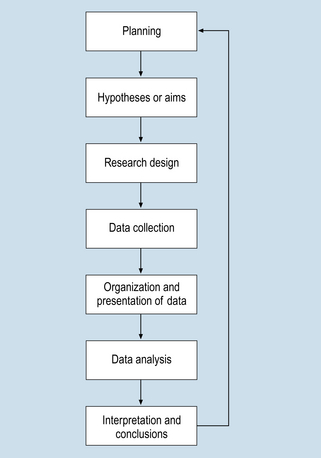3 Although there are differences in how health scientists approach problems, Figure 3.1 shows the steps commonly followed in applied research. You might recognize this as an ‘algorithm’, a general way of solving problems. To illustrate the different steps, we will refer to a published research paper titled ‘A qualitative study of GPs’ views of treating obesity’ by Epstein & Ogden (2005). You should access this publication from the British Journal of General Practice to enable you to follow the steps below. Having identified a problem, our next step is to ask the ‘right’ research question (see Ch. 4). A well-formulated research question will guide the research project in producing the evidence required to answer the question and to solve the research problem. We will discuss in more detail the way researchers formulate questions in Chapter 4. In the case of the paper by Epstein & Ogden (2005), the research problem was the lack of evidence concerning GPs’ views of their treatment approaches to obesity. The research question is: ‘How do general practitioners view the treatment of obesity?’ Therefore, the aim of the researchers was to obtain evidence to describe and understand GPs’ views. Research planning (see Section 2) involves selecting appropriate strategies and data collection techniques to answer research questions and to test the research hypotheses (we explain what these are in Chapter 4). Research planning relies on detailed knowledge of previous research summarized in a literature review. Also, the plan should take into consideration ethical and economic factors before the appropriate data collection strategies are collected and the precise research aims are stated. In addition, the planning process will take into account the target population and formulation of a sampling strategy to select the participants. In the present example, the population was defined as GPs working in London and the sample consisted of 21 GPs who consented to being interviewed for the study. The next step in the research process is the collection of data. We will examine data collection methods employed in health research, including observation, measurement, in-depth interviews and focus groups, in Chapters 11–14. Descriptive statistics are used to organize and summarize quantitative data. Chapters 15–18 examine basic concepts in this area, outlining how graphs and various descriptive statistics are used to condense and communicate research and clinical findings. In qualitative research, the results are often presented in the form of direct quotations of what was expressed. In the study we are examining, the researchers provided a series of direct quotations of GPs’ understanding and management of their patients’ weight problems. The analysis of quantitative data involves applying the principles of probability for calculating confidence intervals and testing the research hypotheses. Inferential statistics and decision-making is outlined in Chapters 19–20. The presentation and analysis of qualitative data involves identifying key themes which provide insights into participants’ personal meanings of events and experiences. The way in which GPs conceptualized their responsibility in the management of obese patients and the role of the patients in this process were two key themes which emerged from the interviews.
The research process
Sequential steps of the research process
1 Research problems and questions
2 Planning
4 Data collection
5 Organization and presentation of the data
6 Data analysis
![]()
Stay updated, free articles. Join our Telegram channel

Full access? Get Clinical Tree


Nurse Key
Fastest Nurse Insight Engine
Get Clinical Tree app for offline access

